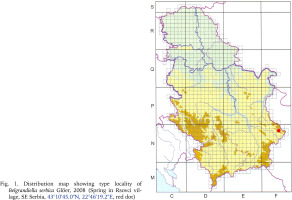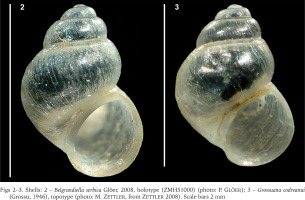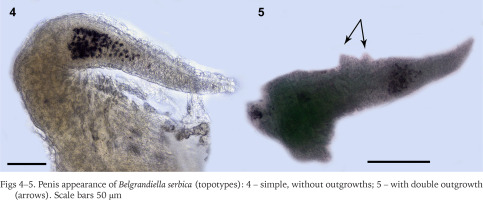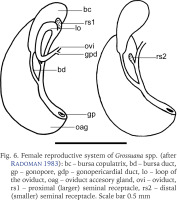INTRODUCTION
Belgrandiella A. J. Wagner, 1928 is a genus of minute operculate freshwater snails inhabiting springs and caves in southern Europe (Osikowski et al. 2018). The number of recent accepted species within this genus is 45 (MolluscaBase 2022a). The shell is slender and simple, the aperture is elliptical and the operculum is usually orange to reddish. The penis is either simple or with an outgrowth present (Radoman 1983). The shell and penial morphology, which are used to distinguish the species, are variable and thus cannot always provide reliable identification. Even though the genus is species rich, the number of species is thought to be greatly overestimated, and the level of restricted endemism in this genus might not be so high (Osikowski et al. 2018). In Serbia, there are only two species recognised, namely: B. bumasta Schütt, 1960 and B. serbica Glöer, 2008 (Marković et al. 2021).
The genus Grossuana Radoman, 1973 is also represented by minute freshwater operculate snails inhabiting mostly springs. This genus is common in the Balkan Peninsula, being present in Serbia, Romania, Bulgaria, North Macedonia, Greece and also Albania (Fehér & Erőss 2009, Falniowski et al. 2016). Altogether 26 species are known within the genus (MolluscaBase 2022b). The shell is ovoid and only rarely slender. The aperture is also ovoid and the operculum is reddish. The penis is simple and frequently with outgrowths (Radoman 1983). In Serbia, there are two species recognised, namely G. euxina (A. J. Wagner, 1928) and G. codreanui (Grossu, 1946) (Radoman 1983, Marković et al. 2021).
In this paper, the Serbian endemic spring snail Belgrandiella serbica Glöer, 2008, described from a spring in Rsovci village (Pirot municipality, SE Serbia) (Fig. 1), and known only from type locality, is synonymised with G. codreanui based on similarities in shell and penial morphology.
Fig. 1
Distribution map showing type locality of Belgrandiella serbica Glöer, 2008 (Spring in Rsovci village, SE Serbia, 43°10'45.0"N, 22°46'19.2"E, red dot)

MATERIAL AND METHODS
The topotypes of B. serbica were collected from the type locality (spring in Rsovci village) by hand. Snails were processed by stereomicroscope Nikon SMZ800N equipped with a Nikon DS-Fi2 camera. Scale bars were made using a Nikon DS-L3 control unit. Collected material, preserved in 70% ethanol, was further processed in the laboratory of Institute of Zoology (Faculty of Biology, Belgrade), where it is also stored.
RESULTS AND DISCUSSION
Superfamily Truncatelloidea Gray, 1840
Family Hydrobiidae W. Stimpson, 1865
Subfamily Belgrandiinae De Stefani, 1877
Genus Grossuana Radoman, 1973
GrossuanaRadoman1973: p. 7
Type species: Grossuana serbica Radoman, 1973 (by original designation)
Grossuana codreanui (Grossu, 1946) (Fig. 2–3)
Figs 2–3
Shells: 2 – Belgrandiella serbica Glöer, 2008, holotype (ZMH51000) (photo: P. Glöer); 3 – Grossuana codreanui (Grossu, 1946), topotype (photo: M. Zettler, from Zettler 2008). Scale bars 2 mm

Paladilhiopsis codreanuiGrossu1946: 203–204, fig. 1.
Grossuana serbica codreanui – Radoman 1983: 58–59, pl. 4, fig. 49.
Belgrandiella serbica – Glöer 2008: 355, fig. 7 (Fig. 2). new synonym.
Type locality: Spring near Balcik (Bulgaria).
Material examined: ca. 100 specimens from the spring in Rsovci village (type locality of B. serbica), leg. V. Gojšina, 07.09.2022.
Description. Shell ovate-conical, consisting of 4–5 convex whorls separated by deep suture. Shell approximately 2 mm high, colourless, with entire body clearly visible through it. Surface very finely, radially striated, almost entirely smooth. Aperture simple, very slightly angulated without any denticles or sinuations. Parietal lip thickened. Umbilicus either entirely closed or slit-like (Figs 2–3). Operculum moderately thick, paucispiral, orange to almost red in colour. Head-foot region whitish to greyish. Mantle entirely black, except for lighter sides. Penis pale, with single blackish blotch present near middle part. Penis wide at base, regularly tapering towards tip. On left side of penis, a simple swelling can be observed (Glöer2008). The swelling may be well or poorly developed (even invisible), and varies greatly within populations (Figs 4–5). Female genital system represented by large bursa copulatrix with long bursa duct, loop of oviduct, accessory glands and two seminal receptacles. Distal receptacle (smaller) joins near junction of oviduct and bursa duct while the proximal (larger) joins loop of oviduct (Fig. 6) (Radoman1983, Szarowska et al. 2007).
Figs 4–5
Penis appearance of Belgrandiella serbica (topotypes): 4 – simple, without outgrowths; 5 – with double outgrowth (arrows). Scale bars 50 μm

Fig. 6
Female reproductive system of Grossuana spp. (after Radoman 1983): bc – bursa copulatrix, bd – bursa duct, gp – gonopore, gdp – gonopericardial duct, lo – loop of the oviduct, oag – oviduct accesory gland, ovi – oviduct, rs1 – proximal (larger) seminal receptacle, rs2 – distal (smaller) seminal receptacle. Scale bar 0.5 mm

Remarks. Belgrandiella serbica was described by Glöer (2008) from the spring in Rsovci village (near the city of Pirot, SE Serbia). The species is described as having the transparent cylindrical-conical shell with 4–5 whorls, deep suture, reddish operculum and a simple penis with a small swollen part (referring to the outgrowth). From the figures, it can be seen that the penis is wide at its base and is tapering towards its tip. Shell dimensions are between 1.9–2.4 mm in height and 1.28–1.48 in width. It is interesting that Radoman (1983) listed G. serbica codreanui (=Grossuana codreanui) from several localities in Serbia, among them also a spring in Rsovci village, the same locality from which B. serbica was described by Glöer (2008). This record was not mentioned in the original description of B. serbica. It seems that the author overlooked this record by Radoman (1983) and did not compare the material with this species. In the original description of Paladilhiopsis codreanui (=G. codreanui), Grossu (1946) described the shell as transparent, conical-globular with 4–4.5 whorls separated by a fairly deep suture. The operculum thin. Shell height is between 1.9–2.3 mm and width is between 1.2–1.5 mm (Grossu 1946). Penial morphology was not mentioned in the original description, but was later analysed by several authors and described as simple, with a double outgrowth on the left side. It is wider at its base and is regularly tapering towards its tip (Zettler 2008, Georgiev et al. 2015). Original descriptions of both species (Grossu 1946, Glöer 2008) are almost identical and the reason why the specimens from Rsovci village were placed in the genus Belgrandiella remains unclear. Comparison of the two species showed that there are no significant differences in shell morphology. However, morphological analyses of the topotypes showed certain level of variability. Some of the dissected specimens have shown the same penial morphology as figured in original description of B. serbica (with a large swelling at the base and a simple outgrowth placed closer to the middle of the penis), some of them had only a single swelling and some of them were even more simple, not showing (or barely showing) any outgrowths. There were also some specimens which showed the similar double outgrowth as frequently mentioned in G. codreanui (Fig. 5). In conclusion, this species is a member of the genus Grossuana because Belgrandiella species are more slender, and usually have more straight-sided shell, whereas Grossuana is more globular. This species is synonymised with G. codreanui based on the following:
Identical shell morphology of the holotype and topotypes of B. serbica and topotype of G. codreanui.
Even though penial morphology of the topotypes of B. serbica showed significant variability, there were some specimens which showed the morphology similar to G. codreanui. Furthermore, this character is clearly very variable within the same population and probably cannot always be used for reliable species identification.
Radoman (1983) recorded G. codreanui (as G. serbica codreanui) from the same spring where B. serbica was described from, and from several other springs as well.
The alternative solution of transferring B. serbica to the genus Grossuana would result in forming a secondary homonym of G. serbica Radoman, 1973 and replacement name will have to be given. However, this will probably result in formation of a new name which will be, at one point, synonymised with already described taxa, since there is no reason to support the distinctness of this species (at least based on the shell and penial morphology). This will also add further confusion in this challenging group of freshwater gastropods.
In order to investigate the true diversity of Grossuana thoroughly, not only in Serbia, but in the whole Balkan Peninsula, a more integrative approach including both morphological, anatomical and molecular studies is needed.

